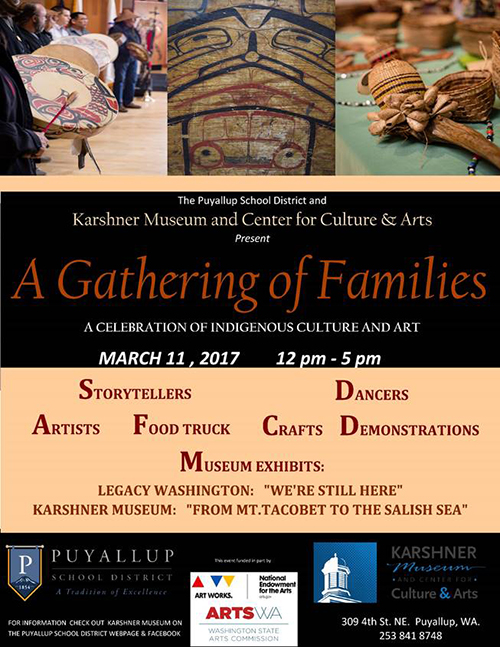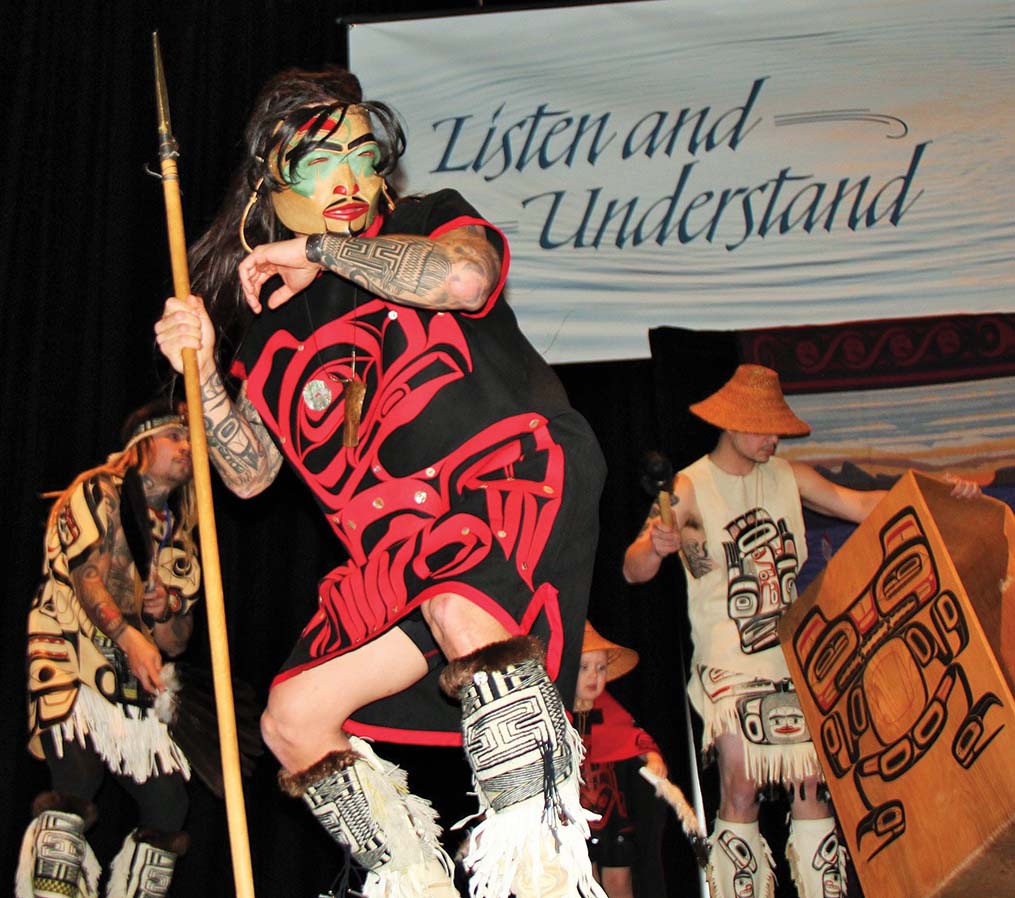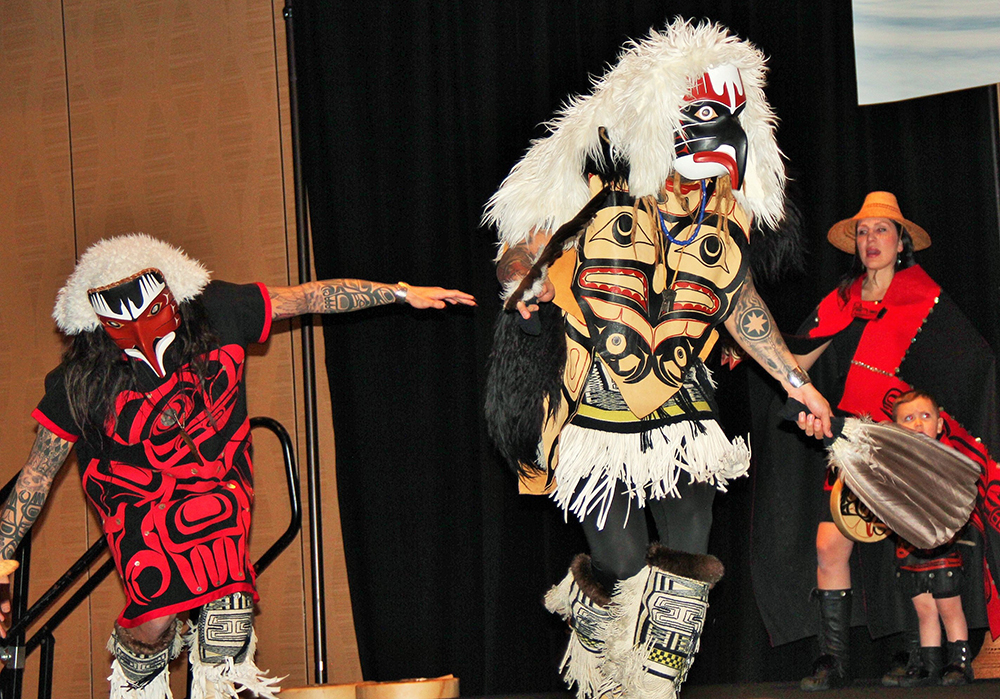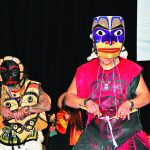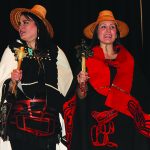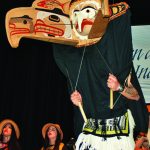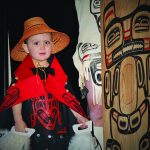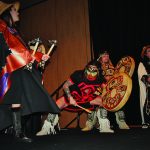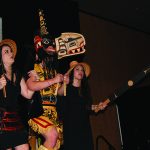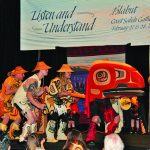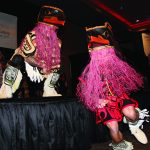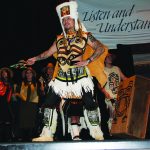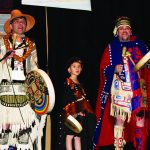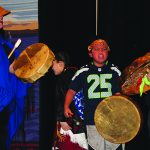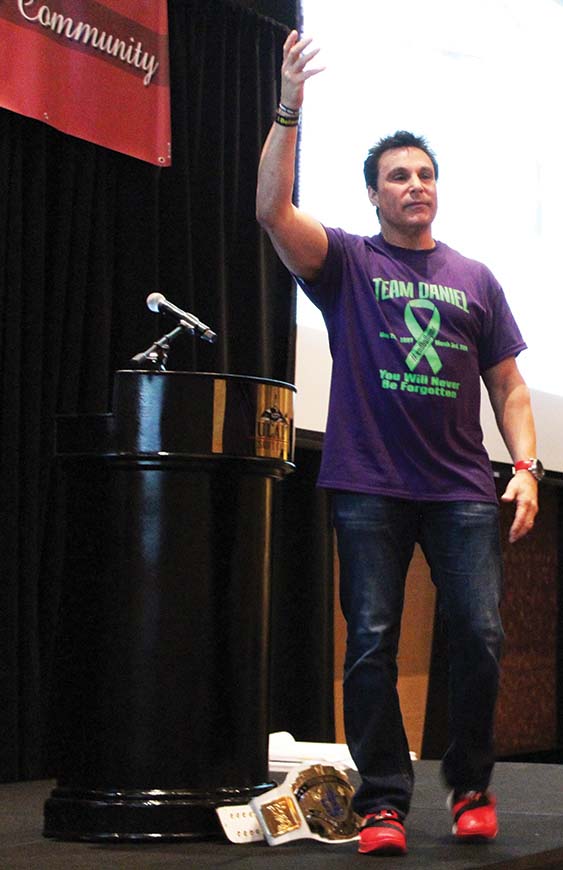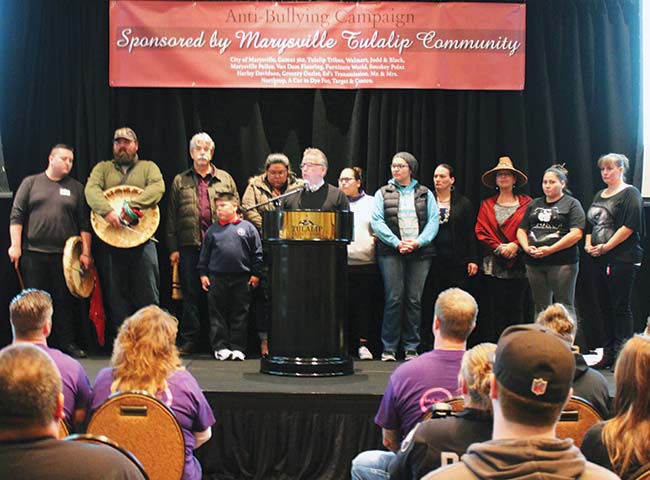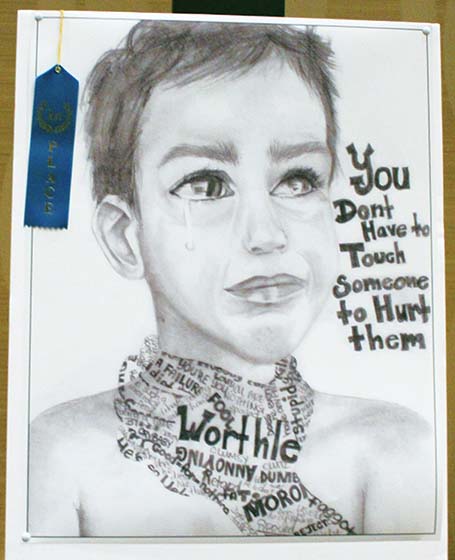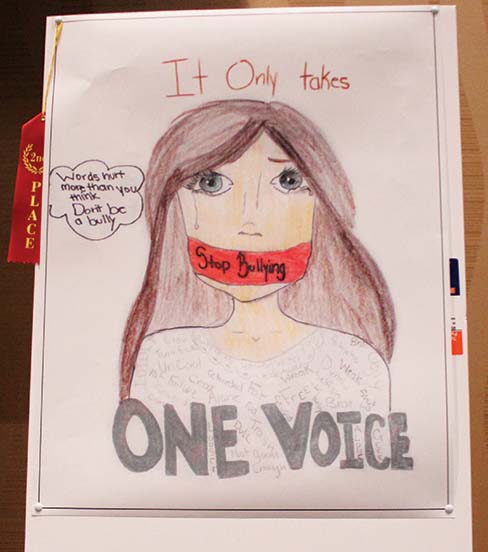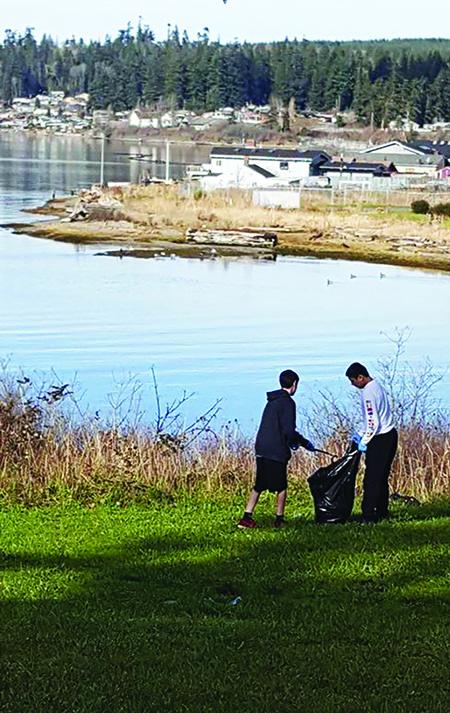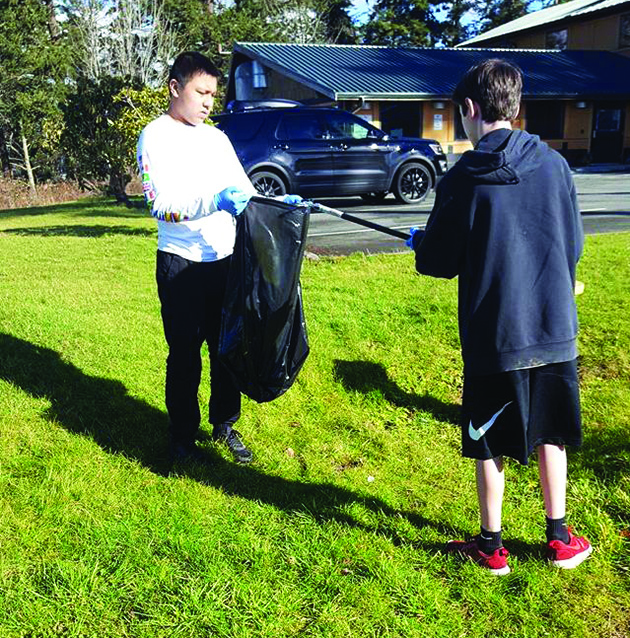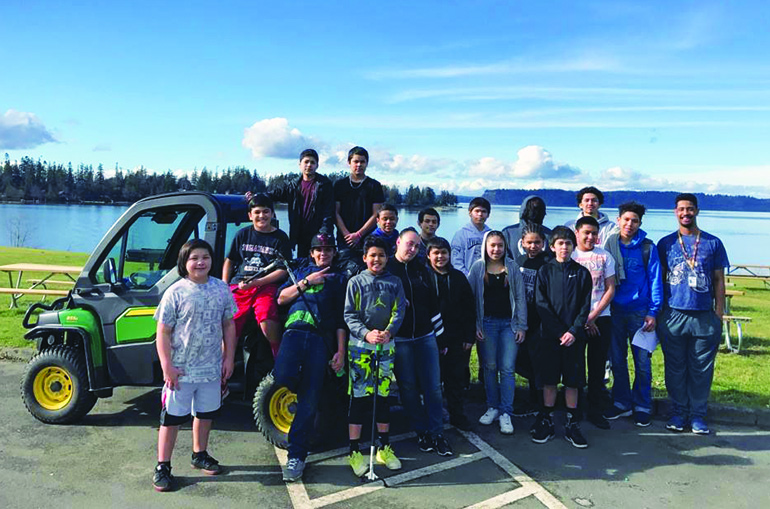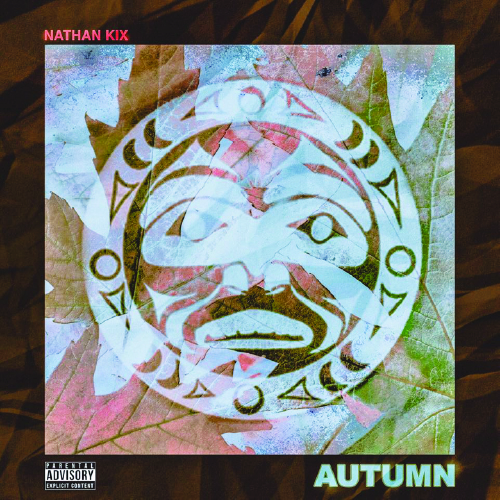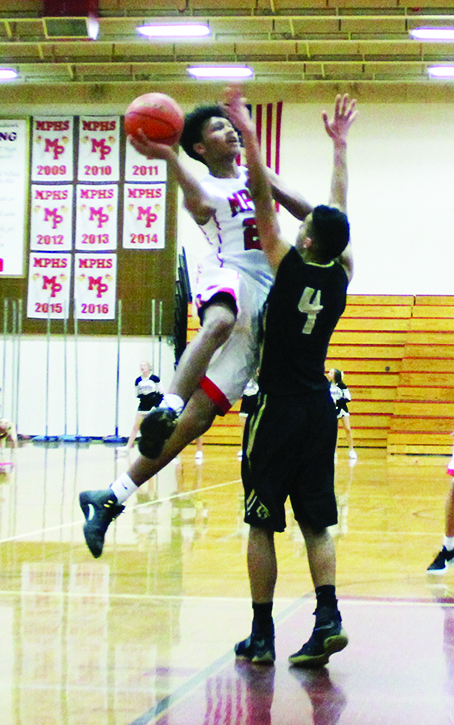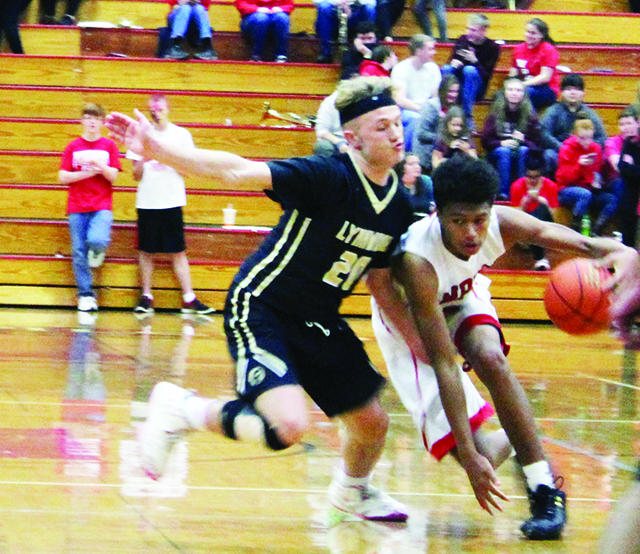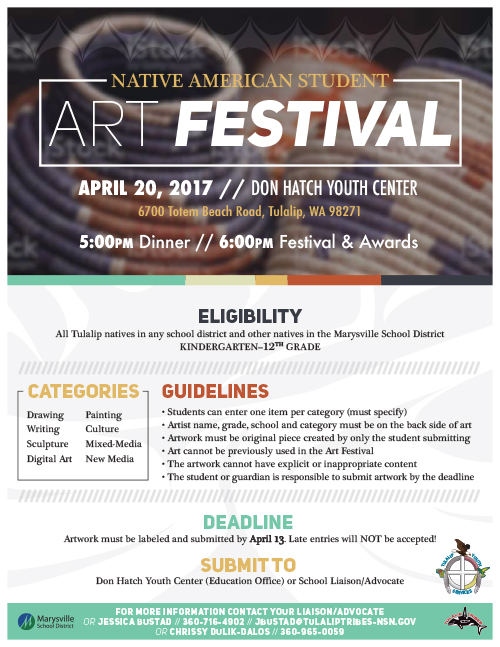Saturday, March 11 is the second annual ‘A Gathering of Families’ The event will feature storytellers, dance groups and Native artists sharing their work and selling. Two exhibits, artifacts from traditional Coast Salish cultures, children’s crafts and a fry bread truck and its all free.
Category: News
A Gathering of Coast Salish peoples
By Micheal Rios, Tulalip News
Western Washington Tribes and British Columbia First Nations of the Salish Sea came together to speak with one voice at the Tulalip Resort Casino’s Orca Ballroom on February 27.
As one voice, the tribal leaders, activists, and caretakers of the environment spoke for the continued protection of the land and waters of our aboriginal homeland and the preservation of our culture. As brothers and sisters, they shared their culture and concerns for the endangered eco-region, and continued their dialogue on the need for strengthened environmental policies and practices in our ancestral homelands.
These Coast Salish ancestral homelands, the Salish Sea and its people continue to face detrimental damages to the environment and resources based on the pollution based economy, and they will continue to move on co-management and co-decision making on the Salish Sea. The agenda for the 2017 gathering was to discuss:
- Aboriginal and Treaty Rights at Risk
- Resource and Environmental Challenges
- Laws, Policy and Regulation
- Coast Salish 21st Century Nations and Tribes
- Federal, State and Tribal Dispute Resolution
- Decision making, uniform consent
Following the day’s seminars and presentations, attendees were treated to an evening filled with traditional song and dance. The next generation of Tulalip drummers, singers, and dancers opened, led by cultural specialist Chelsea Craig.
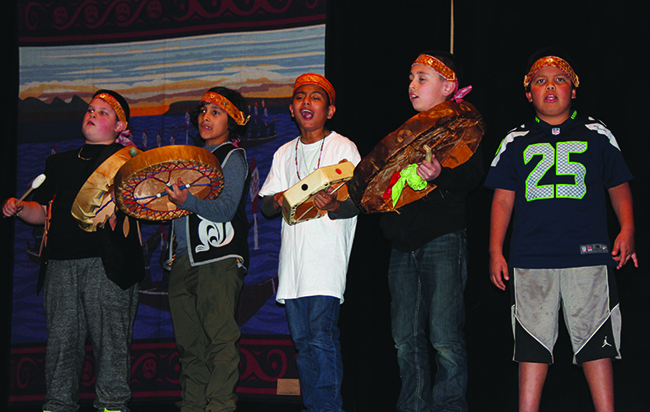
Succeeding the young and spirited Tulalip group was one of the top Native dance groups on the west coast, Git-Hoan.
“We are Git-Hoan, the People of the Salmon. We are a makeup of Tsimshian, Haida, and Tlingit people from southeast Alaska and are proud to be in your territory to sing and dance for you,” stated group creator David Boxley, a renowned Tsimshian artist and carver. “What a beautiful place to dance. Thank you for allowing us to be here.
“This dance group has been in existence since 1996. We use a lot of masks to tell our stories. All of our tribes, including [Tulalip], at one time danced with masks and this form of expression is coming back strong over the last decade. The songs and dances you are about to see are old in their origins, but relatively new in their make-up. Missionaries were very successful with our people. We are trying to change that by [revitalizing our culture] like how it was before the missionaries. We are proud of the fact we try really, really hard to look like the old days, with the masks and telling the stories like our people once did.”
Git-Hoan performed for nearly an hour to the marvel of gathering attendees. Included in their selection of dances was a brand new song debuted for the Coast Salish occasion.
“We are the People of the Salmon, and so are you. We are all People of the Salmon,” explained Boxley. “Historically, our ancestors’ lives depended on the salmon. The next song we are going to show is a brand new song that shows our pride in being People of the Salmon .We dedicate this song to all of you.”
With the conclusion of the day’s events, Board of Director Theresa Sheldon shared her amazement in watching the performances by several Coast Salish tribes.
“It’s always a blessing to see our young students singing our ancestors songs, especially for this Coast Salish Gathering. A gathering that’s all about our Mother Earth and how we can work together on protecting our waterways. It was truly a delight to witness the Alaskan group perform their traditional mask dances. They had the most amazing raven dance, with the mosquito ancestor dance, and the supernatural eagle dance. It’s truly an honor when our relatives bring out their masks to share with us. Sharing our songs and dances together is the way of our people. I’m so thankful to the parents and teachers who help our young ones embrace this.”
Former Pro Wrestler Marc Mero Lays the Smackdown on Bullying
By Kalvin Valdillez, Tulalip News
Prizewinning posters created by students of the Marysville School District (MSD) were on display in the Orca Ballroom of the Tulalip Resort and Casino. The posters promoted anti-bullying messages such as make bullying extinct, stop cyberbullying, and you don’t have to touch someone to hurt them.
The recent Anti-Bullying Community Campaign Event drew large amounts of families from the Tulalip-Marysville community as many were excited to see special guest speaker, former professional wrestler Marc Mero.
Last year MSD School Resource Officers, law officials assigned to the school district, attended an anti-bullying conference in Florida because the cyberbullying epidemic reached the school district and quickly became an issue among many students.
During the conference, the School Resource Officers heard Mero share his inspirational life story, told to assist with bullying prevention and encourage the youth of America to make smarter life decisions. Following Mero’s speech, the officers made it their top priority to bring the WWE Champion to Washington State to talk to students in school district about bullying. Marc presented his message at middle and high school assemblies throughout MSD before concluding with the Tulalip Resort and Casino event.
“Show me your friends and I’ll show you your future,” stated Mero as he urged the youth in attendance to be mindful of the company they keep. Mero, professionally known as Wildman Marc Mero, created a wish list at a young age that contained both his dreams and future dream purchases. Among the various items on the purchase list, stand-outs included a black Cadillac and a house for his mother.
“I was bullied very badly as a kid. My mother worked two jobs to support my siblings and I. We didn’t have a lot of money so we got a lot of our clothes from garage sales,” he remembers. Marc explained that because his classmates discovered he wore articles of clothing they once owned, they nicknamed him ‘bum’, likening his used attire to a homeless person. However, young Mero was able to channel those emotions, triggered by his bullies, into sports. Excelling in a variety of sports, he found his true passion in boxing and fought his way to a New York amateur championship match. Due to an accident that resulted in a broken nose, he was unable to fight for the championship title.
Although he had intentions of returning to the boxing ring, he was restricted from fighting for a year per doctor’s orders. Marc used that time to rekindle old friendships and quickly spiraled into drug and alcohol addiction. He watched ten years of his life pass by, along with any boxing comeback dreams. It was while flipping through television channels that he first watched, and decided to pursue a career in, professional wrestling.
After months of hard work and determination, Mero began to quickly climb to the top of the wrestling world, facing opponents such as The Rock, Stone Cold Steve Austin and Triple H. He was meeting celebrities, making upwards of millions of dollars and married professional model and female wrestler Sable. Most importantly he was finally able to purchase a brand new house for his mother as well as the car of his dreams, the black Cadillac.
Association with the wrong crowd once again led to Mero’s downfall. This time his addiction led to three overdoses, neglected relationships, and a divorce. During his rise to fame Marc would sometimes avoid returning phone calls and letters to his mother and siblings. He would often skip family events such as his brother’s baseball games and his sister’s high school graduation. Marc revealed that at the height of his professional career, he lost his mother due to lung cancer, his younger brother to a head trauma accident and his younger sister to cancer.
“When it all comes down to it, life is about the choices you make. I missed out on the greatest years of my sister’s life, of my brother’s life, and for what? To go and get high?” He continued, “I was a bully too. I bullied my family. All they wanted to do was play catch with me or sit next to me. I was so mean to them and I regret it every day. I would tell them to quit bugging me or I would tell them to go away. What I would give to go back in time and throw one ball to my brother or hold my sister tightly while she sat next to me. Make sure the people that you surround yourself with will build you up and not tear you down,” he urged.
Marc spoke about the emotional harm bullying causes, stating that suicide is currently the third leading cause of death amongst teenagers in the United States. And the majority of suicide deaths are bully related. Mero invited mother and schoolteacher Amy Briggs on stage to share a story about her son Daniel. At the young age of sixteen, he had been ruthlessly bullied for years from his peers in school. Daniel was often told to ‘kill himself’, verbiage that is unfortunately seen quite often among high school students nationwide across various social media platforms.
One night Daniel received a text from a classmate asking him to save the world from misery by ending his life. He replied stating the world would not have to worry much longer because he was planning to take his life soon. The classmate responded ‘put up or shut up’. The next day Daniel told other classmates of his intentions and was met with similar reactions. And that afternoon, while his parents were at his brother’s basketball game, Daniel died from a self-inflicted gunshot wound.
As tears streamed down many faces of event attendees, Amy urged parents who have children that are constantly harassed online or at school, to join forces with other parents to put a stop to bullying. “There truly are some teachers and administrators who don’t believe bullying is really a problem. My voice was only heard once or twice but you can’t ignore three hundred voices in a board room at the same time,” she stated.
Mero explained that sometimes when kids bully other kids, it is because they are victims of bullying themselves. He advises that a one-on-one conversation between a bully and an adult can lead to both the revelation of the issue causing the harassment as well as a solution to the issue.
Before thanking the crowd for their attention to this serious issue, Marc gave a possible explanation as to why some kids attempt suicide. “Maybe their parents are going through a divorce, maybe they had a death in the family, maybe they lost their pet, maybe they have a medical condition [their bullies] know nothing about. And it’s that one text, that one message that pushes them over the edge. Behind every text are real people with real feelings,” he stressed to the youth.
For more details about the life and career of Wildman Marc Mero, including information about his organization Champion of Choices, please visit www.thinkpoz.org
Team Up to Clean Up
Article by Micheal Rios; photos courtesy of Rachel Steve
Armed with litter pickers, garbage bags, and protective gloves, twenty-eight dedicated Tulalip youth committed a sunny Friday afternoon to beautifying the Youth Center and its surrounding area.
The community cleanup event was organized by Youth Services Activities Specialist, Rachel Steeve, and took place on February 17.
“Youth Services was very pleased with the turn out,” explains Rachel. “The kids were pretty optimistic about cleaning up their most popular hangout spot, and there wasn’t one complaint. Going into it we all thought it was going to rain, but instead the sun came out for us and made it a beautiful day. We are blessed to have such an amazing building and even more blessed the kids take ownership and care for their building.”
Community cleanup is a great way to improve the environment while working alongside fellow community members on a hands-on, high-visibility service project. When you love your community, you want to make sure it looks its best.
“The kids cleaned for 1.5 hours then we took them to Altitude Trampoline Park for two hours as a reward,” continues Rachel. “Work hard, play hard! The reward was well worth it. The kids had a blast jumping. It took all the hard working staff to carry out such a successful event.”
Over the duration of the cleanup the environmentally conscious group removed bags and bags of litter and debris from the roadways, parking lots, nature trails, and ball fields surrounding the Youth Center.
Cleaning up your neighborhood park is a rewarding project for all community members, regardless of age or occupation. In fact, it really helps to have plenty of young workers. Cleaning up your neighborhood park is one of the few neighborhood activities where youthful stamina is more critical than good judgment. It’s visual, we can see the results, and you’re only asking volunteers for a few hours on one occasion.
“Tulalip Youth Services would like to thank the twenty-eight youth who showed up to help pick up garbage in the community,” states Josh Fryberg, Youth Services Activities Coordinator. “We will be planning more days like this in the future and hope to see the same or more participants. Let’s continue to make a difference together.”
Wellness Court is now in session
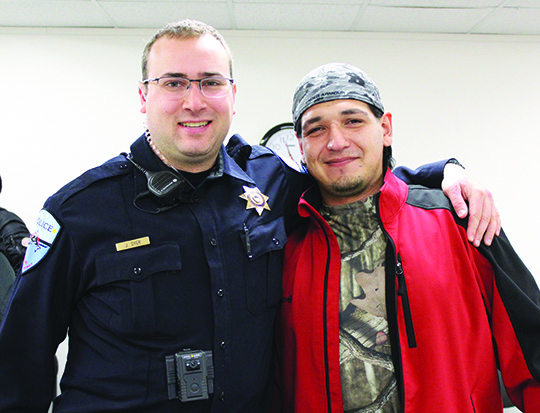
By Kalvin Valdillez, Tulalip News
The heroin and opioid epidemic has hit America hard in recent years. According to a study conducted by the University of Washington Alcohol and Drug Abuse Institute, thirty-one percent of deaths statewide can be credited to drug overdose. The epidemic has unfortunately claimed the lives of many loved ones nationwide. Previously, addicts who wanted to become clean would often fail because they were not provided with the proper resources and tools while attempting to become sober. In many cases, addicts are eventually caught with possession of drugs, and sometimes turn to thievery for the intent of supplying their high, and are reported to the authorities. The traditional court is a flawed system when it comes to dealing with individuals who committed a non-violent crime fueled by their addiction. For this reason, drug courts were invented. Drug courts can be found nationwide and are utilized by individuals who are battling addiction and were convicted on drug-related charges.
The state of Washington sees approximately three thousand deaths annually due to drug abuse, according to the Washington State Department of Health. In Snohomish County there are around six to seven hundred drug related casualties per year, with the largest amount of overdoses occurring in Everett, Marysville and Tulalip. Tulalip has made an enormous effort to help heal their people in the form of the Healing to Wellness Court. There are many similarities between drug court and Tulalip’s Wellness Court, such as random drug tests, required court appearances, and numerous resources. Tulalip has modified the drug court model to fit the needs of addicted tribal members, ensuring that there’s an emphasis on culture and community with the new Wellness Court.
“The difference from drug court is mostly the integration of the cultural programs and the community the program is in. In Wellness Court we ask our participants to be in the community,” states Wellness Court judge, Ron Whitener. “A lot of the participants have to rebuild their relationships with the community because a lot of them have burned some bridges on their way into Wellness Court. It is something positive they can work on while they are also working on their treatment and education. We want to help reintegrate them back into this community.”
Wellness Court is held once a week on Tuesdays, and participants are required to stay for the entire duration of court. The court sessions, typically an hour long, display a new twist to the traditional courtroom scene. Participants approach the podium to speak to Judge Whitener directly about their struggles and successes each week. Wellness Court uses a system of sanctions and incentives to help keep their clients on track. Sanctions include increased court appearances, community service hours and writing assignments. While incentives include gift cards, movie passes, decreased court appearances and later curfews.
“Our goal is to heal the individual completely, not just the addiction,“ states Wellness Court Coordinator Hilary Sotomish. The Wellness Court team works as a cohesive unit, meeting weekly to review each participant’s progress, ensuring that everybody is on the same page as communication is key amongst the Wellness Court team. The team is comprised of members from several departments including Behavioral Health and Recovery, the Healing Lodge, Housing Hope, Tulalip Housing, the Karen I. Fryberg Health Clinic, University of Washington Tribal Public Defense Clinic, and the Tulalip Police Department.
The Tulalip Police Department assigned three officers to the Wellness Court team. The officers take on a new role, at least from the participant’s perspective, as they interact in a positive, supportive manner while encouraging participants during their road to recovery. Current participants are happy to see the officers in the community and often converse with the officers about their weekly progress.
Tulalip Police Chief Carlos Echevarria states, “Wellness Court allows my law enforcement officers to have greater interactions with the participants. Often the officers will stop by and say hello and ask them how they are doing. We ensure we are providing positive feedback and often the officers will take the time to listen to what the participants have to say. They are building great relationships with each other.”
The five-stage program has no fee with the exception of a fifty-dollar GPS ankle device, which is used to monitor the location of the participant as well to ensure that curfews are met. Cultural activities such as sweat lodge, red road to sobriety and other local events are encouraged.
“Our goal is to keep people involved and to work to help them. As long as the individual is showing they are committed to working and trying, we are going to keep working and trying,” states Hilary.
Tulalip tribal member Robin Hood approached the judge on his twenty-fifth day sober -an accomplishment met with tremendous applaud from the judge and the courtroom, to talk about his past week. Robin is currently staying at the Healing Lodge and attended two more than the required group therapy sessions. However, he missed one of his daily call-ins and received a write-up from the Healing Lodge, which resulted in sanctions of two hours of community service and a one-page written essay on why he missed his daily call in.
“Wellness court can be an easy process, you just got to show up every day and do what is required. It’s only hard if you make it hard, that’s my motto. My experience is going fine. I’m doing this because I know that other people will follow so I’m trying to be a leader. I think this is a positive thing for myself and for my community, and it’s working,” Hood states. “Like my dad always says, ‘it works, if you work it’. Another quote I like is, ‘chase your sobriety like you chase the dope man.’ That’s exactly how sobriety works; you got to want it. If you ain’t wanting it, you ain’t getting it. I’m really glad I’m here. The wellness team has been there to support me one hundred percent. If it wasn’t for them I wouldn’t be clean and sober.”
For more information about the Healing to Wellness Court please contact (360) 716-4773.
Tulalip Child Advocacy Center receives accreditation
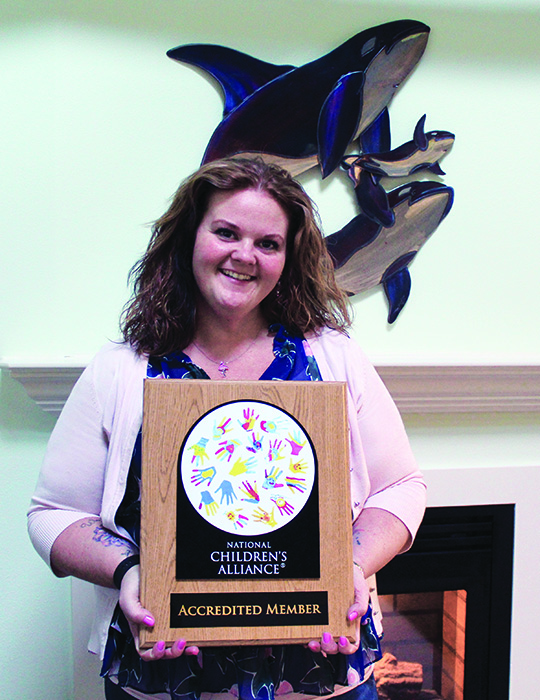
By Kalvin Valdillez, Tulalip News
The National Children’s Alliance (NCA) is the accrediting body for Child Advocacy Centers nationwide. Child Advocacy Centers, often referred to as CACs, conduct forensic interviews as well as provide therapy and assistance to the victims of child sexual abuse and their non-offending family members. In order for a CAC to earn accreditation, the center must pass an extensive application process as well as an on-site review process.
“There was a grandma whose grandchild had been sexually abused. She told the prosecutor that her granddaughter had been repeatedly traumatized by all the questioning she had to go through in order to get to the actual case in court. The prosecutor on the case thought, oh my God, that’s probably true. He started the first CAC ever with a team comprised of law enforcement, CPS [child protective services] and criminal justice members, ensuring everyone was on the same page and the child would not have to retell their horrific stories over and over,” states Jade Carela, Legacy of Healing Child Advocacy Center Manager.
The Tulalip CAC has a multi-disciplinary team that includes members of the Tulalip Police Detectives, CPS, beda?chelh, the Tulalip domestic violence and sexual assault prosecutor, and FBI detectives as well as the child advocate.
The NCA regularly updates their policies and procedures and requires a re-accreditation process every five years for each CAC. The accreditation holds centers to a higher standard and indicates exceptional service and a quality center.
The accreditation process often requires over a year’s worth of preparation. However, under the direction of Jade, Tulalip now has the only accredited CAC on a reservation, in Washington State. The enormous task was accomplished in an impressive three short months. When a CAC receives accreditation, they have achieved the highest level of recognition with the NCA.
The Tulalip CAC offers innocent children victims of sexual abuse a chance to heal. The recent accreditation shows the strong effort the Tribe is making to ensure that the victims receive the best possible care, as well as justice and assistance through the entire court process.
For additional information on the accreditation of the Tulalip Legacy of Healing Child Advocacy Center please contact (360) 716-5437.
On a Wave: Tulalip artist Nathan Kix ‘holds it down’ for Native American and hip-hop culture
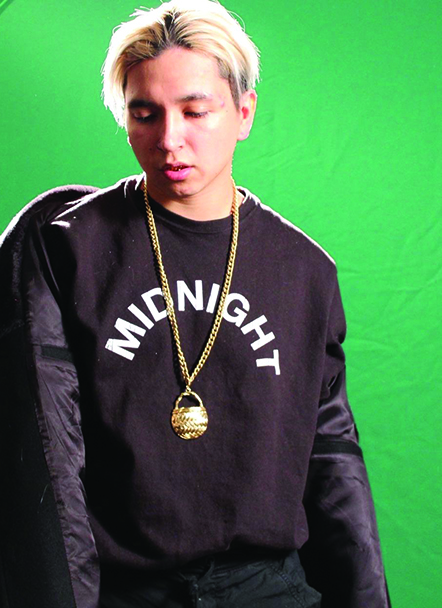
Photo/Kalvin Validillez, Tulalip News
By Kalvin Valdillez, Tulalip News
Cool, calm and collected is the demeanor of Tulalip hip-hop artist, Nathan Kix. Still in his early twenties he has his mind set on the future, looking to be the first Native artist to crossover to music mainstream. Many Indigenous rappers such as Litefoot and Red Cloud have seen success and have spread their voices throughout reservations nationwide. However, their fan base has been limited to the Native American community.
Nathan and his team have created a unique modern sound that emphasizes his clever wordplay. Until recently Nathan was releasing singles on Soundcloud, which revealed glimpses of his musical direction. He released his debut project this past December, on his birthday, in the form of a six-track EP titled Autumn which has received positive reviews across social media. And he is only beginning, stating his future projects will each contain a unique sound as he plans to build a strong catalog during the course of his music career.
With a fan base that continues to grow by the day, I have no doubt in my mind that Kix could be the first Native rapper to break down genre barriers. I personally met Nathan a few years back while we were both working as concierge’ for the T Spa at the Tulalip Resort and Casino. As an avid hip-hop enthusiast myself, I would often talk music, recite Jay Z lyrics and even drop the occasional freestyle with Nate during downtime at the spa (when no guests were around, of course). Which is why I was excited to sit down and talk with the young emcee about his new release, culture, and of course the genre of music that captivated us both at a young age: hip-hop.
Let’s start off by talking about your background. Has growing up on the reservation affected your writing?
For the most part I’ve kept my culture modest, up until this point. Solely for the fact I feel I don’t want to expose too much too early. I want to appeal to as many people as possible, strictly through human experience, without playing the culture card. I don’t want to use that to gain popularity. I want to build my skill level. So, at this point it hasn’t [affected the writing] but it does inspire why I want to do this.
What is your writing process?
When I first started, I used to write without a beat, which was a burden when it came time to record because I couldn’t stay on beat. But I stuck with it and kept writing. Once I figured out what bars were, it was a field day. With the writing process now, I am very punch line oriented. I studied Lil’ Wayne’s delivery and wittiness, and took those components and made it my own. When writing today, I will loop the beat and figure out the exact flow first, like how many syllables I can fit into particular verse or line and once I figure that out, I’ll pause the beat and keep flowing in my head, until I get it down, and then plop the words in.
Was there a defining moment when you knew this is what you’re supposed to do?
I started writing raps around seven or eight, but they were trash and I was one of those people who want to be good at something right away. I realized [at that time] I wasn’t good, so I held off until I was about sixteen, and then I gave it another shot.
At the beginning of my sophomore year, there was this one girl who I was trying to, you know, holler at. She actually asked me to have a rap battle on paper. I was like ‘oh okay,’ you know whatever it takes to keep the conversation going. Ever since then I’ve enjoyed the process [of writing], so that was the defining moment for me. Whenever I get the chance to talk to her, I still let her know she was the one who got the ball rolling.
What’s the story behind the name Nathan Kix?
Roughly around that same time [in high school], I started getting into personal style. The one thing I enjoyed the most about an outfit were the shoes, that’s switched up now, but I was known in high school for having all the Jordan’s and all the fly shoes. People identified me as the dude who had forty different pairs of shoes. Every day, for at least a month and a half, I wore a different pair. That’s basically where the name came from.
How important is originality?
Originality is everything. I can’t emphasize that enough. If you want to progress a genre and make your stamp, originality is going to take you there. There are artists out there who cut and paste styles from already established artists and [by doing so] they make it well known that they aren’t on their own wave. Originality should be the focal point when becoming an artist.
Who is your biggest musical inspiration?
It’s a toss-up between two or three people. I really fell in love with Kanye West’s music when he came out with My Beautiful Dark Twisted Fantasy. I liked Kanye [before] but that album really sparked my interest and made me want to become a better artist. Drake always had a huge impact on the way I approach the phycology of writing. And, Jim Morrison for the creativity and the depth he brings to writing music.
If you could collaborate with one artist who would it be? Producer?
A$AP Rocky. For producer, I have to go with ’Ye (Kanye West).
How do you feel about the local hip-hop scene?
I don’t feel like there really is one, but we definitely need it. I feel like it would create a lot of creative ventures for people. If you have all these creative minds such as videographers, photographers, and graphic designers coming together, who can contribute to improve the image of an artist, the scene can essentially build everybody up.
Where do you see your art taking you?
Representing all the First Nations people. Like, the Shoni Schimmel of music. Basically what I am trying to do is bring Natives into the mainstream. Shoni Schimmel dipped her finger in the water; I want to be the person to create the biggest wave out of [the water]. When I do, I want to look back at my people and help them find a way to creatively express themselves, because there are passionate Natives out here and I want to help create a market for them.
What separates you from your competition?
The awareness of how to be different; I like to incorporate the modern sound with my own textures. I have a producer who I work with, Paul Koshak. He produced Autumn, well ninety-eight percent of it. Mason Gobin, who is also a tribal member, produced half of [the song] 100 Thousand.
I think a lot of rappers aren’t giving it their all, as far as song content. I feel like that is my sole focus and I am able to deliver that in a very witty way.
Why did you decide to go with the Moon, in traditional Native artwork, for your album cover?
The moon is representing that something new is about to happen. The moon comes every night and provides you with a new day. So in a way, it is the same concept of Autumn. You see the leaves falling every autumn, signifying new change.
Most people go with a summer vibe with their music because everyone likes to feel good. My favorite season is autumn because the gloominess it has. When the leaves fall, there is a gap of time where it feels like nothing is happening. That’s the overall vibe: transition.
I feel like I made a huge change in my life, within this last year, mentally. It felt like I was dropping as many leaves as possible, I still feel like I’m in that phase, but I know they are going to grow back and blossom as beautiful as ever. That’s the metaphor behind [the artwork and concept].
Prior to the release of Autumn, you dropped a documentary that showed you in the studio as well as in the community. Shortly after the EP came out, you released a music video for your song Gravity. How important were those videos to your overall presentation?
They were very crucial, especially the documentary because it gave people a taste of what exactly I am about. A lot of people may perceive me as bashful; when in reality I’m just introverted. The documentary allowed me to show what I’m doing and why I’m doing it, without having to spoon-feed it to you.
The [music] video was not a calculated move. We shot it back in the summertime and we didn’t actually have anything planned for it. People were responding and saying they really appreciated Autumn so director Luis Perez – a phenomenal photographer/videographer – sent me a text and wanted to release the video. We picked the date and dropped it on Christmas Eve.
The EP has received a lot of love – what has been the best feedback you received?
I enjoy any type of feedback I get, but the best feedback has been from people I didn’t even expect to give it a listen. Sometimes when walking around, people will stop me and tell me they’ve been listening to my songs. When they tell me they like my music in person, that’s what I appreciate the most.
You’ve talked about your collective a lot, the group of creative minds that you work with. How important is it to have your group with you, as you gain more exposure going forward?
I feel like it’s necessary to have a team because you’re not going to always be the one with the right idea. There are decisions that have to be made, that have nothing to do with the craft itself. Having a team behind you to take things on, such as business ventures, that is something that an artist can benefit from.
Having your own team is basically like having your own label. I feel like I would rather give a percentage [of profits] to the people I know. I think most artists are taking this route because they realized that record labels will rip your soul apart. When it’s with people you know, you feel a more genuine connection.
Do you plan on staying on the independent grind or would you sign the right deal?
If they had my agenda in mind, and allowed me to operate at the speed that I’m comfortable working at, I might consider it. Even then, I don’t believe I would fully commit to a label. If anything, I would like to do a publishing deal to handle all the business ventures such as marketing.
What is one record label you would consider?
I’m not sure if I would necessarily fit at any of the labels. But I would maybe consider [signing a deal with] G.O.O.D. Music (Kanye’s record label) because they have a lot of diversity going on over there. I love OVO (Drake’s record label) and what they are doing; they have a certain aesthetic they are keeping. I don’t feel like I sound anything like them, so I don’t think I would mesh well, in that aspect, same with T.D.E. (Top Dawg Entertainment, record label associated with Kendrick Lamar)
A top to bottom Autumn performance would be lit! Do you plan on performing in the near future?
Yeah, like I mentioned before, the [local hip hop] scene needs to be more prominent. I would like to work with the right promoters to make sure that our shows are the best they can be for us, and for the people as well. I also have a lot more songs than the six-track EP, so we’re looking at possible set lists and looking at other local acts as well. There’s a lot of talent around here and we want to do multiple shows. There are definitely plans for live performances; we’re just ironing out the details.
Who are you currently listening to and who is on your top-three emcee list?
Most of the time what I like to listen to is the polar opposite of what I make. Right now it’s a lot of Lil Uzi Vert, this artist named 6lack he made that song PRBLMS, I love that joint. I’ve also been bumping a lot of Frank Ocean. Syd, from [the music group] The Internet, just dropped a solo project that is amazing. I also go back in time too; I love The Doors.
And for top three, these are not in order and they all have reasons for being on here: Kanye West, Drake, and Travis Scott. I would say they are the most influential to me.
If you could change a common misconception about the hip-hop culture what would it be?
I want people to respect how artistic and influential this genre is. Because, agree with it or not, rap is the new rock and roll.
How about in Native culture?
The stereotypes. Also, that we are unexposed to the world outside of the reservation.
What do you want tribal members to take away from your music?
That there is somebody out here looking to expose our culture to the world.
And my advice for young aspiring Native artists is to go with your gut instinct on what exactly you want to portray yourself as, and make sure that everything you’re doing stays true to yourself and is original as well.
Autumn is currently available on iTunes, Apple Music, Spotify and Soundcloud with plans of a physical release in the near future. To view the documentary, the music video for Gravity, and for additional information visit the Nathan Kix Facebook page.
Ball is Life for RaeQuan Battle
By Kalvin Valdillez, Tulalip News
When RaeQuan Battle was in the third grade he was recruited by Cyrus “Bubba” Hatch to play in a basketball tournament at Lummi. At the time, young RaeQuan hadn’t really given basketball much thought, because his favorite sport was football. RaeQuan accepted the invitation and not only did his team win the championship, but he was presented with the Most Valuable Player award, resulting in a new love for the game.
Now a sophomore at Marysville Pilchuck High School (MP), Battle devotes the majority of his time to perfecting his basketball skills and focusing on his grades. He advises young hoopers to put down their smart phones and pay attention during class because at the young age of fifteen, he is aware of the opportunities a good education can offer.
College will begin in a short couple of years for RaeQuan. This is something he is well-aware of and has already started thinking of where he would like to attend. He states, “I would want to play [college basketball] for Kentucky, but I’m looking [into] the University of Washington. A lot of my family members love UW, so that’s a school I would have to consider.”
Family is indeed of great importance to him, citing his grandfather, Hank Williams, as his biggest inspiration. Every time Battle suits up for a game, he puts on a jersey with the number twenty-one on display. He chose twenty-one because it is his mother’s favorite number. A few of his relatives also wore that number when playing for MP.
The basketball season for MP recently concluded with an appearance in the playoffs as RaeQuan’s squad battled for a shot at State. Standing at six-foot, four-inches Battle towers over most of his teammates as well as the competition. He is effective on both ends of the floor often getting buckets and grabbing boards. His favorite position to play is small forward, a position that is played by NBA stars such as Kevin Durant and Lebron James. His height advantage, paired with his skill, gives him the versatility to play any spot on the floor, and MP utilized him in every position throughout their season.
Battle states that basketball has given him a strong work ethic and has taught him many valuable lessons that he can apply on and off the court. “The biggest thing I’ve learned is how to stay humble. When I first started playing I used to get benched because I didn’t have the right attitude. If you want to improve your game or get anything productive accomplished, you have to remain humble and focused,” he states.
Now that the basketball season is over RaeQuan will participate in some extra-curricular activities including driver’s education and track, but the majority of his time will be spent studying. However, he vows to continue to get in the gym and work on his game during the off-season as he continues to follow his dream of playing in the NBA.
Udall Addresses National Congress of American Indians
Commits to being ‘a strong voice and advocate for all Tribes’ as vice chair of Senate Indian Affairs Committee

